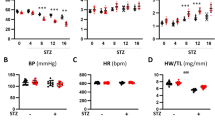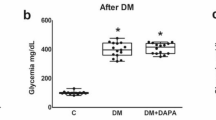Abstract
Methods: Diabetes was induced by an intravenous injection of streptozotocin (60 mg/kg). Following diagnosis of diabetes, treatment was initiated by supplementing the drinking water with PLC at a concentration of 1 g/L for a period of 6 weeks. ATP production and TCA cycle activity were determined from oxidative rates of glucose and palmitate measured in isolated working hearts from control and diabetic animals.
Results: The effect of diabetes was associated with a decrease in heart function, expressed as rate-pressure product (RPP), and in rates of myocardial glucose oxidation. Rates of palmitate oxidation in diabetic hearts were similar to those of control hearts. In PLC-treated diabetic hearts, rates of both glucose and palmitate oxidation were increased and a significant improvement in RPP was observed. As a result, overall ATP production and TCA cycle activity from glucose and palmitate oxidation were increased in diabetic hearts.
Conclusion: Our results indicate that the depression in RPP in the diabetic rat heart can be prevented with chronic PLC treatment. Increases in glucose and palmitate utilization with resultant increases in ATP production and TCA cycle activity may explain the benefit of PLC on diabetic rat heart function.







Similar content being viewed by others
References
Fisher BM, Gillen G, Lindop GBM, et al. Cardiac function and coronary arteriography in asymptomatic type I (insulin-dependent) diabetic patients: evidence for a specific diabetic heart disease. Diabetologia 1986; 29: 706–12
Fang ZY, Prins JB, Marwick TH. Diabetic cardiomyopathy: evidence, mechanisms, and therapeutic implications. Endocr Rev 2004; 4: 543–67
Garcia MJ, McNamara PM, Gordon T, et al. Morbidity and mortality in diabetes in the Framingham population. Diabetes 1974; 23: 105–11
Kannel WB, Hjortland M, Castelli WP. The role of diabetes in congestive heart failure: the Framingham study. Am J Cardiol 1974; 34: 29–34
Ferrari R, Merli E, Cicchitelli G, et al. Therapeutic effects of L- carnitine and propionyl-L-carnitine on cardiovascular diseases: a review. Ann N Y Acad Sci 2004; 1033: 79–91
Arsenian MA. Carnitine and its derivatives in cardiovascular disease. Prog Cardiovasc Dis 1997; 40: 265–86
Bartels GL, Remme WJ, Pillay M, et al. Acute improvement of cardiac function with intravenous L-propionylcarnitine in humans. J Cardiovasc Pharmacol 1992; 20: 157–64
Ferrari R, DeGuili F. The propionyl-L-carnitine hypothesis: an alternative approach to treating heart failure. J Card Fail 1997; 3: 217–24
Anand I, Chandrashekhan AI, DeGiuli F, et al. Acute and chronic effects of propionyl-L-carnitine on the hemodynamics, exercise capacity, and hormones in patients with congestive heart failure. Cardiovasc Drugs Ther 1998; 12: 291–9
Broderick TL, Haloftis G, Paulson DJ. L-propionylcarnitine enhancement of substrate oxidation and mitochondrial respiration in the diabetic rat heart. J Mol Cell Cardiol 1996; 28: 331–40
Felix C, Gillis M, Driedzic WR, et al. Effects of propionyl-L-carnitine on isolated mitochondrial respiration in the reperfused diabetic rat heart. Diabetes Res Clin Pract 2001; 53: 17–24
Broderick TL, Paulson DH, Gillis M. Effects of propionyl-L-carnitine on mitochondrial respiration and post-ischaemic cardiac function in the ischaemic underperfused diabetic rat heart. Drugs R&D 2004; 5: 191–201
Paulson DJ, Shug AL, Zhao J. Protection of the ischemic diabetic heart by L-propionylcarnitine therapy. Mol Cell Biochem 1992; 116: 131–7
Terada R, Matsubara T, Koh N, et al. Effects of propionyl-L-carnitine on cardiac dysfunction in streptozotocin-diabetic rats. Eur J Pharmacol 1998; 357: 185–91
Broderick TL, Driedzic W, Paulson DJ. Propionyl-L-carnitine effects on postischemic recovery of heart function and substrate oxidation in the diabetic rat. Mol Cell Biochem 2000; 206: 151–7
Paulson DJ, Traxler J, Schmidt M, et al. Protection of the ischaemic myocardium by L-propionylcarnitine: effects on recovery of cardiac output after ischaemia and reperfusion, carnitine transport, and fatty acid oxidation. Cardiovasc Res 1986; 20: 536–41
Liedtke AJ, DeMaison L, Nellis S. Effects of L-propionylcarnitine on mechanical recovery during reflow in intact hearts. Am J Physiol 1988; 255: H169–76
Tassani V, Cattapan F, Magnanimi L, et al. Anaplerotic effect of propionyl-L-carnitine in rat heart mitochondria. Biochem Biophys Res Comm 1994; 198: 949–52
Lysiak W, Lilly K, DiLisa F, et al. Quantification of the effect of L-carnitine on the levels of acid-soluble short-chain acyl CoA in rat heart and liver mitochondria. J Biol Chem 1988; 263: 1511–6
Broderick TL, Quinney HA, Lopaschuk GD. Carnitine stimulation of glucose oxidation in the fatty acid perfused isolated working rat heart. J Biol Chem 1992; 267: 3758–63
Taegtmeyer H, Passmore JM. Defective energy metabolism in the heart in diabetes. Lancet 1985; 1: 139–41
Lopaschuk GD. Abnormal mechanical function in diabetes: relationship to altered myocardial carbohydrate/lipid metabolism. Coron Artery Dis 1996; 7: 116–23
Rodrigues B, Cam MC, McNeill JH. Myocardial substrate metabolism: implications for diabetic cardiomyopathy. J Mol Cell Cardiol 1995; 27: 169–79
Garvey WT, Hardin D, Juhaszova M, et al. Effects of diabetes on myocardial glucose transporter systems in rats: implications for diabetic cardiomyopathy. Am J Physiol 1993; 264: H837–H44
Stanley WC, Recchia FA, Lopaschuk GD. Myocardial substrate metabolism in the normal and failing heart. Physiol Rev 2005; 85: 1093–129
TL Broderick, M Gillis, P Poirier. Exercise training restores abnormal myocardial glucose utilization and cardiac function in diabetes. Diab Metabol Res Rev 2005; 21: 44–50
McVeigh JJ, Lopaschuk GD. Dichloroacetate stimulation of glucose oxidation improves recovery of ischemic rat hearts. Am J Physiol 1990; 259: H1070–85
McCormack JG, Barr RL, Wolff AA, et al. Ranolazine stimulates glucose oxidation in the normoxic, ischemic and reperfused ischemic hearts. Circulation 1996; 93: 135–42
Packer L, Valenza M, Serbinova E, et al. Free radical scavenging is involved in the protective effect of L-propionyl-carnitine against ischemia-reperfusion injury of the heart. Arch Biochem Biophys 1991; 288: 533–7
Kerbey AL, Vary TC, Randle PJ. Molecular mechanisms regulating glucose oxidation. Basic Res Cardiol 1985; 80 Suppl. 2: 93–6
Broderick TL, Quinney HA, Lopaschuk GD. L-carnitine increases glucose metabolism and mechanical function following ischemia in diabetic rat heart. Cardiovasc Res 1995; 29: 373–8
Acknowledgements
No sources of funding were used to assist in the preparation of this study. The author has no conflicts of interest that are directly relevant to the content of this study.
Author information
Authors and Affiliations
Corresponding author
Rights and permissions
About this article
Cite this article
Broderick, T.L. ATP Production and TCA Activity are Stimulated by Propionyl-L-Carnitine in the Diabetic Rat Heart. Drugs R&D 9, 83–91 (2008). https://doi.org/10.2165/00126839-200809020-00003
Published:
Issue Date:
DOI: https://doi.org/10.2165/00126839-200809020-00003




